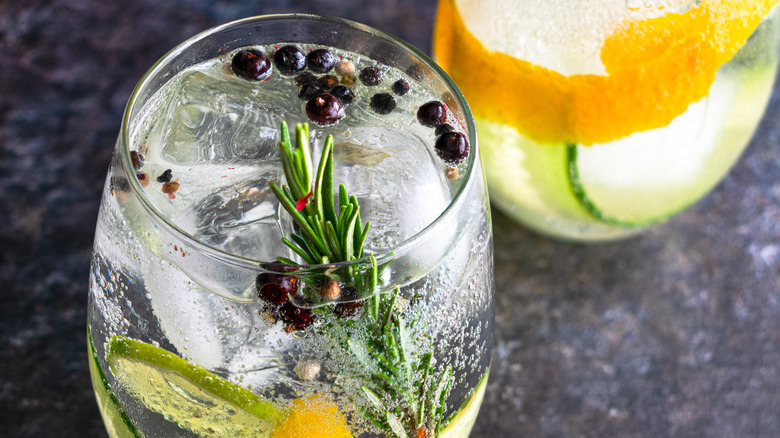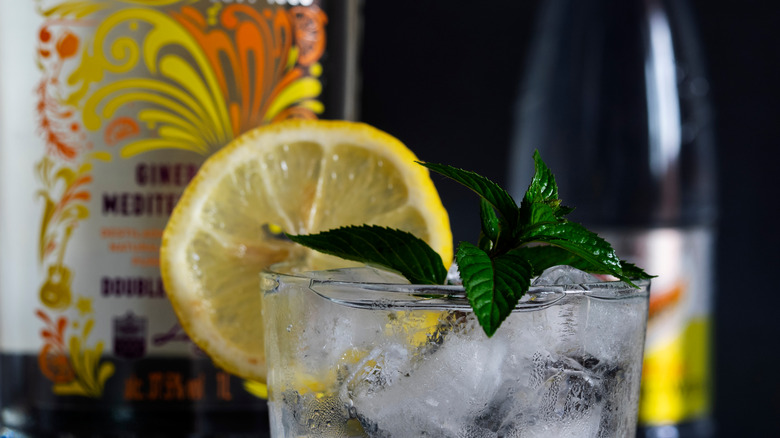What Makes A Spanish Gin And Tonic Stand Out From The Classic?
Part of the gin and tonic's appeal is certainly its simplicity. A two-ingredient cocktail that's easy for both bartenders and drinkers of any experience level to understand, and a drink that tastes amazing any time of year. What's more, the gin and tonic's simple recipe is also a great foundation to perfect, build upon, and expand with additional flavors. The Spanish realized the gin and tonic's true potential centuries ago, and they have since developed their own regional twist that's definitely worth a sip.
The Spanish gin and tonic has the same basic building blocks of a regular gin and tonic: gin and tonic water. However, in this drink, the individual components are thoughtfully considered and combined to create an experience that's more delicious than what you might get when you go to your local bar and order a "G and T." So let's look at what exactly makes a Spanish gin and tonic different, and why you should consider trying one the next time you go out.
What makes a Spanish gin and tonic distinct
A Spanish gin and tonic is all about finding ways to elevate the taste of the ingredients. That begins with high-quality and, most importantly, fresh tonic water. Having fresh tonic water, as opposed to tonic water from a 2-liter bottle or even a bar's beverage-dispensing hose, better complements the flavors of the gin.
Next is the gin, which doesn't need to come from Spain, but should be floral, herbaceous, or otherwise interesting. Add to that an extra flavoring ingredient, such as bitters or liqueur, that plays up the profile of the gin. So a Spanish gin and tonic made with a gin that has notes of lemon might also have a dash of lemon bitters, and one made with a distinctly spicy gin could have hot pepper-infused bitters.
The final element in a Spanish gin and tonic is its serving glass, which is a kind of stemware called a copa glass. It looks like an exceptionally round red wine glass and creates an environment where the aromas from the gin, tonic, and bitters can fully bloom and let you savor them. It's also tradition to serve Spanish gin and tonics with plenty of ice cubes so the drink stays cool even on a hot day, as well as fruit or herb garnishes to add visual flair.
What you need to make the perfect Spanish gin and tonic
Thankfully, you can make an excellent Spanish gin and tonic at home without any fancy equipment. To start, find a gin with a flavor profile that interests you. If you like fruity and tart drinks, go for a gin that mentions having notes of lemon or citrus on its label. If you prefer more peppery or herb-forward gins, choose one that tends toward those flavors. If you can't tell a gin's flavor profile by reading its label or product description online, you can ask someone at your local liquor store to help you find the right one.
Finding good tonic water is usually easier and requires less research. If your tonic water comes in single-serving glass bottles, you have what you need. As for your glass, you can substitute a red wine glass if you're not ready to commit to buying copa glasses.
Your choice of extra flavorings is completely up to you. Any online or brick-and-mortar liquor store should have a selection of bitters and liqueurs to choose from, and you can accentuate these flavors by adding garnishes such as lemon wedges, whole juniper berries, or fresh herbs. In recent years, abundant and elaborate garnishes have become another signature of the Spanish gin and tonic, so feel free to go as big as you want with those.
Check out our guide on how to make the perfect gin and tonic to learn the steps to mix the drink at home. Then kick back and pretend that you're basking in Basque country.


